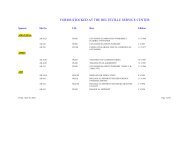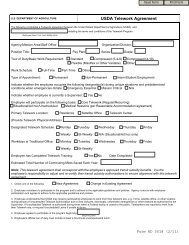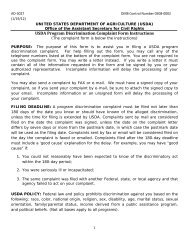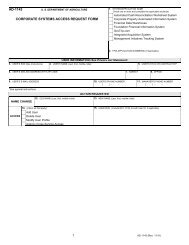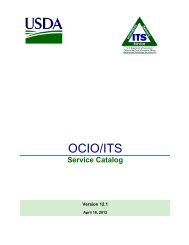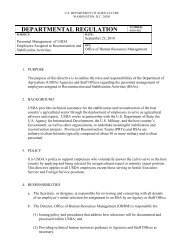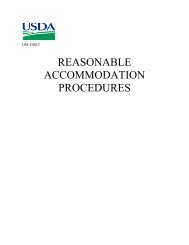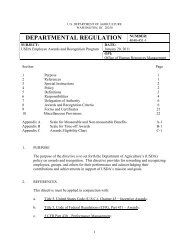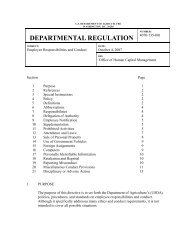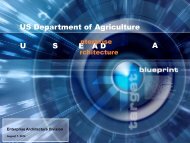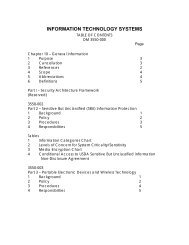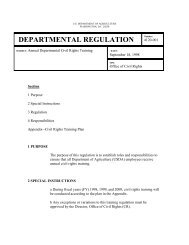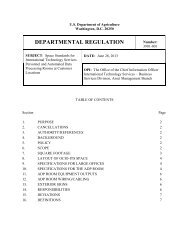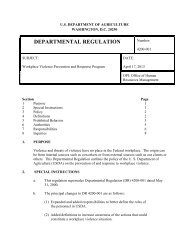thin client solution - OCIO Home Page - US Department of Agriculture
thin client solution - OCIO Home Page - US Department of Agriculture
thin client solution - OCIO Home Page - US Department of Agriculture
You also want an ePaper? Increase the reach of your titles
YUMPU automatically turns print PDFs into web optimized ePapers that Google loves.
Traditional telephone networks devote an entire phone<br />
line to the transmission <strong>of</strong> a conversation. With Voice over<br />
Internet Protocol (VoIP), conversations are digitized, compressed,<br />
and transmitted over a network that also carries<br />
data. As a result, VoIP uses substantially less bandwidth than<br />
a traditional telephone call and can consequently be more<br />
cost effective. Because VoIP voice packets are transmitted in<br />
a fashion similar to other data, users can attach documents<br />
to voice messages. In addition, call waiting, call forwarding,<br />
call blocking, and caller identification (caller ID) are typically<br />
standard features <strong>of</strong> VoIP and can be easily activated by<br />
system administrators at no extra charge. VoIP handsets are<br />
usually small and lightweight enough to be easily moved from<br />
location to location wi<strong>thin</strong> the same VoIP network. Thus, it<br />
is important to note that migration to a VoIP network from a<br />
traditional telephone network requires replacement handsets<br />
as well as network components.<br />
In an effort to take advantage <strong>of</strong> the benefits <strong>of</strong> VoIP, six <strong>of</strong><br />
<strong>US</strong>DA’s largest agencies have already implemented independent<br />
VoIP networks based on different technologies. While<br />
this approach supports individual agency missions, it leads to<br />
redundant resources and can result in a lack <strong>of</strong> interoper-<br />
ability between networks across the enterprise.<br />
More than a year ago, <strong>US</strong>DA agencies and staff <strong>of</strong>fices<br />
launched Phase I <strong>of</strong> an enterprise-wide VoIP initiative to<br />
ensure that next-generation VoIP projects meet common<br />
standards, eliminate redundancies, and optimize end-to-end<br />
performance. The VoIP working group comprised nearly<br />
forty agency representatives and two contractors — one to<br />
document requirements, perform baseline research and deliver<br />
findings; the other, to develop baseline standards.<br />
Working group members discovered that VoIP standards<br />
are generally still immature, and though many <strong>of</strong> them are<br />
adopted by national and international standards organizations,<br />
vendors' implementations <strong>of</strong> such standards still vary.<br />
Moving forward, working group members agreed that<br />
Internet Protocol (IP) deployments should evolve toward<br />
common enterprise architecture with each new acquisition.<br />
They also determined that:<br />
• Enterprise IP architecture should promote flexible and<br />
forward-<strong>thin</strong>king interoperable standards to avoid becoming<br />
a source <strong>of</strong> technology stagnation in the <strong>US</strong>DA.<br />
• The enterprise network backbone will require technology<br />
upgrades to maintain current levels <strong>of</strong> availability and<br />
quality <strong>of</strong> service for both voice and data to support unified<br />
IP requirements.<br />
• Agencies must be willing to support Universal Telecommunications<br />
Network/UTN-to-the-desk connectivity to avoid<br />
unnecessary “hops” between legacy local area networks<br />
and the enterprise backbone. This will enable network<br />
Introducing VoIP<br />
by Susan Moore<br />
<strong>Page</strong> 4<br />
operations troubleshooting to the desktop and end-to-end<br />
security enhancements.<br />
<strong>US</strong>DA has now transitioned to Phase II which is managed<br />
by <strong>US</strong>DA’s Technical Review Board (TRB), a change control<br />
board established to maintain the integrity <strong>of</strong> the <strong>US</strong>DA enterprise<br />
network backbone. The TRB has formed an Integrated<br />
IP Standards Subcommittee and VoIP Working Group that<br />
will make recommendations for the definition, prioritization,<br />
and enterprise-wide adoption <strong>of</strong> integrated IP standards to the<br />
<strong>US</strong>DA Executive Change Control Board (ECCB). The ECCB<br />
will review the TRB recommendations and submit them for<br />
approval to the <strong>US</strong>DA Chief Information Officer. In addition,<br />
the subgroup plans to:<br />
• Review and comment on IP Acquisition Approval Requests;<br />
• Identify and recommend <strong>Department</strong>-wide standards for<br />
network IP services such as Voice and Video over IP;<br />
• Implement a strategy for migrating from stove-pipe legacy<br />
IP networks into a single, unified IP enterprise backbone;<br />
• Develop and implement a governance strategy and guidelines<br />
for managing IP technologies across the <strong>Department</strong>;<br />
• Manage processes for maintaining IP network configuration<br />
change control;<br />
• Establish processes for incorporating IP into the <strong>US</strong>DA<br />
Enterprise Architecture;<br />
• Promote enterprise–wide IP acquisitions; and<br />
• Make recommendations for <strong>US</strong>DA enterprise policy on IP<br />
technologies.<br />
Agencies that have an IP installed base and those interested<br />
in IP technology will have an opportunity to actively<br />
participate in the TRB Integrated IP Standards Subcommittee<br />
and VoIP Working Group. For more information contact<br />
Vernelle Archer, TRB Chairperson, at: 301-504-2040.<br />
Did You Know?<br />
In Fiscal Year 2008, Washington Communications and<br />
Technology Services processed more than 200 million<br />
messages, trapped more than 156 million spam messages,<br />
and answered more than 14,064 Employee Locator<br />
inquiries.<br />
Q<br />
Upon request, the Controller Operations Division,<br />
Customer Liaison and Training Branch conducts training<br />
sessions for <strong>US</strong>DA agencies in New Orleans, Washington,<br />
D.C., or an agency site on a fee-for-service basis.<br />
Continuing Pr<strong>of</strong>essional Education credits are awarded<br />
upon successful completion <strong>of</strong> the course. For more<br />
information, call (504) 426-5471, or email:<br />
customer.training@usda.gov



